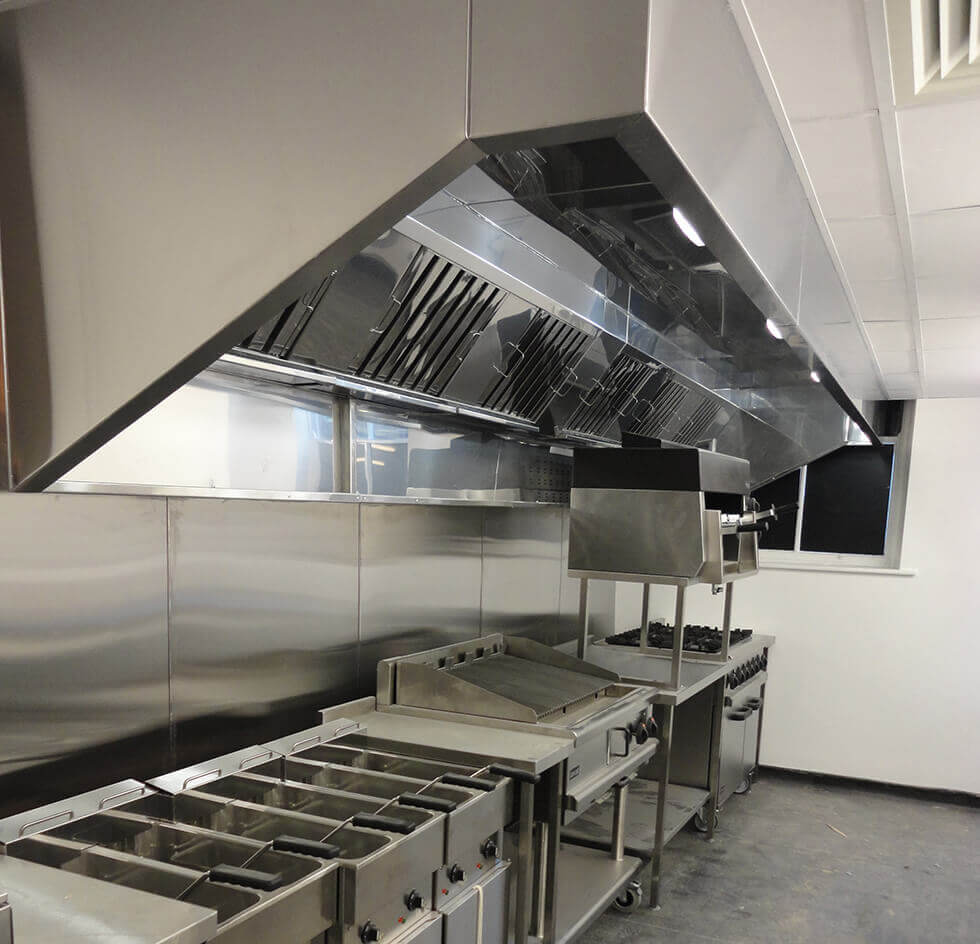Dolphin Fabrications have the facility to provide fully working 2D & 3D kitchen ventilation layout drawings. These include flow-rate charts. We usually combine a site visit with a drawing proposal to gauge the exact fan requirements and ducting routes before work commences.
What do we offer?
Kitchen ventilation canopies fall into two categories; wall type & island type. Wall canopies are typically slightly triangular in profile and often have stainless steel wall cladding incorporated beneath them to protect the supporting wall from heat damage.
An island canopy is usually suspended from the roof structure (however we can make this free-standing also) and spans a far greater footprint than the wall canopy. Island canopies also usually have a stainless-steel services chamber with riser than provides support and protection for the gas manifold, water supplies & electrical supplies.
Modern kitchens are often a prime threat in terms of fires because they have constant high temperatures and flammable liquids. We supply fire suppression systems to safeguard your home against this eventuality. Our systems work mainly via water mist, which is released from nozzles above the kitchen appliances and works to tackle fires, not only by cooling but also by reducing the oxygen take-up of the fire, thus also preventing further damage to your vital equipment.
Ducting routes, fan sizing, odour neutralisers and volume control are all commonly dealt with aspects for the successful installation of a compliant kitchen ventilation system. At Dolphin we manufacture and supply our own ducting systems to deal with all individual site requirements. Our fans are locally sourced in Sheffield along with our various methods of both odour and volume control.
BS6173:2009 was introduced in 2009 and relates to commercial kitchens. It states gas should not be available if the ventilation fans are not operating. Proving of the fans can be done either by air pressure differential switches or a current monitor. If either at start-up, or during the day, the fans fail or are turned off the gas valve should close.
Another aspect of BS6173:2009 is gas pressure proving. The standard states if any of the catering equipment does not have a flame failure device a gas pressure proving system should be installed. At start-up, the panel is to check the gas line to ensure no appliances are in the “on” position. This is to ensure gas cannot escape into an area that could possibly be unsupervised.
BS6173:2009 relates to commercial kitchens which are either new or which are having a major Refurbishment. In the eyes of GAS SAFE a major refurbishment is when a kitchen either has a new fan or canopy fitted, or if additional or larger appliances are fitted. For instance if a four ring burner is replaced with another four ring burner GAS SAFE do not consider this to be a major refurbishment and therefore it does not have to comply with BS6173:2009. However the people who are operating the kitchen must be informed the kitchen is NCS (not up to current standard) and that it should be brought up to standard if a major refurbishment takes place in the future.
Dolphin oversee the complete installation of gas interlock systems including supplying and fitting the gas solenoid valve, undertaking all field wiring required and wiring/commissioning the panel and fans.
For large scale projects it is becoming more and more common for the kitchens fresh-air-in supply to be tempered in order to prevent staff working in cold conditions. We are able to provide and install both electric and LPHW heater batteries.
Our recommendation to a site would always be electric as there are almost no maintenance costs with such a system however we do appreciate that sites tend to struggle with the KW loadings demanded. Therefor if a LPHW system is opted for we recommend at the same time fitting a 30KW dedicated gas boiler within the kitchen locality to serve the heater battery. By doing this the system can be operated at 83deg (often buildings existing heating systems are limited to 65deg for H&S) and glycol can be introduced as a further measure against freezing (assuming it is already frost protected).





